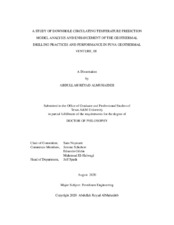| dc.description.abstract | Study 1 :
Drilling complexity has been increasing over the years. With deeper targets, the oil and gas industry is reaching record high downhole temperatures. For these high temperature regions, a special and a careful consideration is needed during the well planning to choose proper drilling tools and fluids. This research investigates and improves the downhole temperature model prediction in a commercial software by reviewing the calculation steps and analyzing the source equations. In addition, a full analysis of the model’s inputs is performed. Moreover, the research coupled the model’s prediction with actual high temperature data from the Austin Chalk to test the model’s accuracy. The study also provides a detailed sensitivity analysis for different drilling parameters and their effects on the downhole temperature with the model and the actual data. These parameters include the flow rate, type of drilling fluids, pipe rotation (RPM), and others. An improved temperature model is developed and a new workflow in the commercial software is introduced based on this research. The new model eliminates the overestimation spikes in the downhole temperature profile by calculating the downhole torque of the motor based on the differential pressure. Also, the improved version utilizes the measured downhole torque data.
Study 2 :
Geothermal drilling has increased in the recent years with the renewable energy initiatives. Geothermal plants provide more than 6% of California’s electricity. A large sum from the development budget is consumed by the drilling. This research reviews the drilling activities and operations in Puna Geothermal Venture in Hawaii for more than twenty years. Six challenges were identified and analyzed. These challenges include: lost circulation, stuck pipe, cementing, low Rate of Penetration (ROP), logistics issues, and safety concerns. Then, the drilling performance of the field is compared with several oil and gas fields as well as geothermal drilling activities around the globe. The result shows that the drilling in Puna Venture can be enhanced significantly. A set of recommendations to improve the performance is presented as organizational and workflow changes, analysis and elimination of Non Productive Time (NPT), and engineering redesigns. | en |


